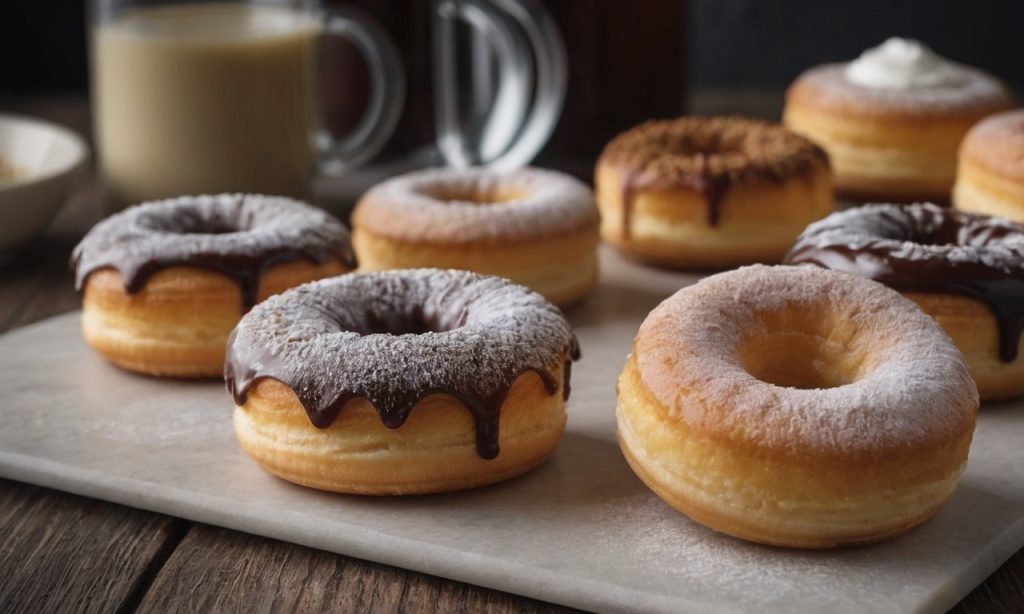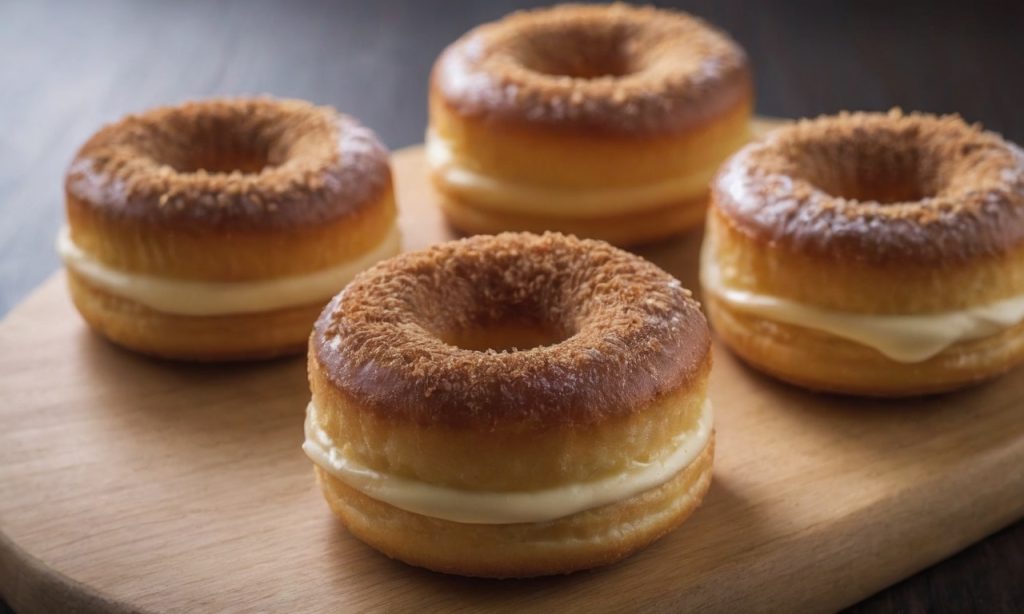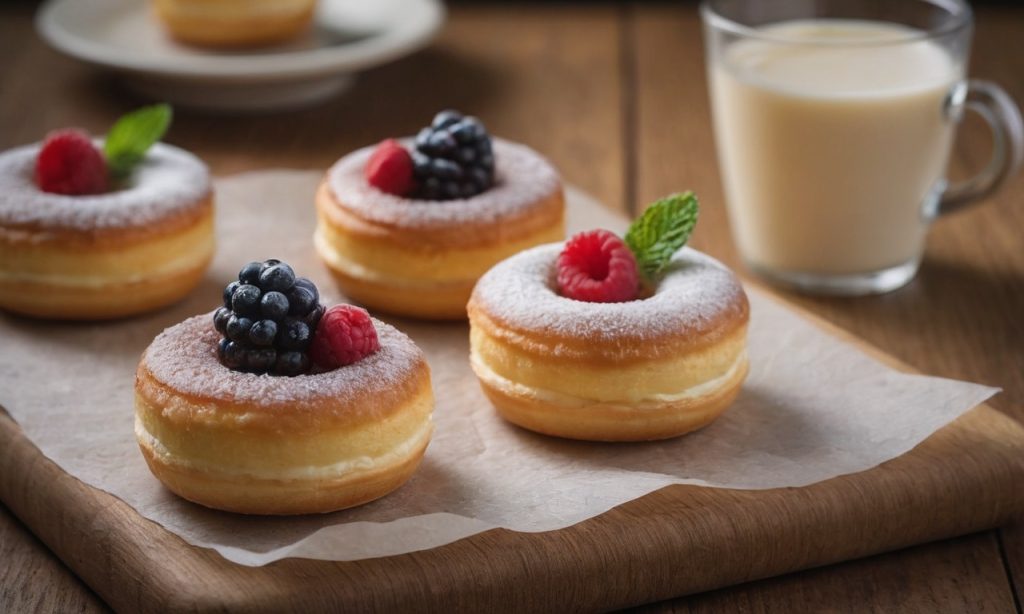Embark on a culinary adventure with our detailed Cronut Recipe guide, blending the elegance of croissants with the classic delight of donuts. This comprehensive article is your gateway to perfecting the Cronut Recipe at home, complete with nuanced instructions and insider tips to elevate your baking experience.
Discovering the Cronut Recipe: A Culinary Hybrid

Ah, the Cronut! A pastry that has danced on the tongues of dessert lovers and left many a food critic swooning. But what exactly is this culinary hybrid that has taken the world by storm? At its heart, a Cronut is a glorious marriage between a croissant and a donut, boasting the flaky, buttery layers of the former and the sweet, deep-fried delight of the latter. It’s a testament to culinary creativity and a symbol of dessert innovation that has sparked a global sensation.
The inception of the Cronut can be traced back to the bustling streets of New York City, where pastry chef Dominique Ansel unveiled this masterpiece in 2013. Little did he know, his creation would soon become a global phenomenon, with eager food enthusiasts lining up outside his bakery just to get a taste of this artisanal treat. The Cronut‘s allure lies not just in its taste but in its unique texture and the intricate process required to achieve it.
But fear not, dear reader, for the magic of the Cronut is not confined to the walls of gourmet bakeries. With a pinch of patience and a dash of passion, you too can recreate this flaky wonder in your own kitchen. So, let’s set forth on this baking adventure, armed with a rolling pin and a sprinkle of culinary curiosity, as we delve into the world of Cronuts. Ready your aprons, for we are about to unfold the secrets behind baking the perfect Cronut—a journey that promises both challenge and reward, with each buttery layer leading us closer to pastry perfection.
Cronut Recipe Essentials: Ingredients and Preparation

Ingredients Overview
Embarking on the Cronut journey begins with gathering the right ensemble of ingredients. The foundation of this pastry marvel lies in its dough, reminiscent of a croissant’s, requiring high-quality bread flour for that quintessential structure and chew. A pinch of kosher salt and a sprinkle of granulated sugar balance the flavors, while instant yeast works its magic to give the dough its rise and airiness.
The foundation of a successful Cronut Recipe lies in its ingredients. High-quality bread flour, a touch of kosher salt, and the right amount of granulated sugar set the stage for this exquisite pastry. The role of instant yeast in our Cronut Recipe cannot be overstated, as it’s crucial for achieving the airy layers that define a Cronut.
Water, cold and refreshing, binds these elements together, and an egg white adds to the dough’s elasticity. The heart of the Cronut, however, is the unsalted butter, layered within the dough to create those sought-after flaky textures. And let’s not forget the heavy cream, enriching the dough with its luxurious fat content.
For the crowning glory, the Champagne Chocolate Ganache (sans the champagne for a non-alcoholic version) and glaze, we delve into a concoction of water, heavy cream, unsweetened cocoa powder, egg yolks, granulated sugar, and dark chocolate. This ganache, rich and velvety, will be the filling that elevates the Cronut from merely good to sublime.
Step-by-Step Recipe Guide
Preparing the Dough
The journey to a perfect Cronut Recipe begins with the dough. Mixing the dry ingredients forms the base, while the addition of cold water and egg white brings the dough to life. The lamination process, where butter is folded into the dough, is pivotal in our Cronut Recipe, creating the pastry’s signature flaky texture.
The adventure begins with mixing the dry ingredients—flour, salt, sugar, and yeast—before introducing the cold water and egg white. This mixture, once combined, is the first step towards our flaky goal. The dough then embarks on its first proofing, doubling in size and promising the layers we so desire.
Making the Champagne Chocolate Ganache
A standout Cronut Recipe features not just the dough but also the filling. The Champagne Chocolate Ganache, though we’ll keep it non-alcoholic, is a creamy, rich addition that complements the flaky dough beautifully, making each bite of your Cronut Recipe a delightful experience.
In a pot, we combine cream (holding back on any alcohol to keep it family-friendly) and cocoa powder, whisking them into a warm embrace. The egg yolks and sugar join the dance, tempering and thickening into a custard that will envelop our dark chocolate, transforming it into a ganache of utter indulgence.
Frying and Assembling Cronuts
With our dough rolled and rested, and our ganache chilled to perfection, we cut our Cronuts into their iconic shape. A gentle bath in hot oil puffs them up to golden brown beauties, ready to be filled with the ganache that’s been whipped into a light, airy filling. A roll in sugar and a drizzle of glaze later, and voilà—the Cronut is born, a testament to the joy of baking and the magic of patience.
In this symphony of ingredients and steps, each plays its part to create a Cronut that’s not just a treat, but an experience. As we move forward, remember, the beauty of baking lies in the journey as much as in the destination. So, take a moment to savor the process, for each step brings us closer to creating a pastry that’s nothing short of a masterpiece.
Pro Tips for Perfecting Your Cronut Recipe

Navigating the intricate dance of Cronut creation is akin to conducting a symphony—every element must harmonize perfectly. Here are some insider tips and tricks to ensure your pastry hits all the right notes, resulting in a standing ovation from your taste buds.
Achieving the Perfect Flaky Layers
The secret to those mesmerizing layers lies in the butter—cold, yet pliable. When incorporating the butter into the dough, ensure it’s not too hard; otherwise, it’ll tear through the layers. Conversely, if it’s too soft, it’ll meld into the dough, and the distinct layers will be lost. Aim for a consistency that’s just right, allowing you to fold and roll without the butter breaking or oozing out.
Temperature plays a pivotal role here. Keep the dough and butter chilled, but not so cold that they become unworkable. This delicate balance ensures that when the Cronut hits the hot oil, the water in the dough and butter turns to steam, puffing up the layers and creating that sought-after flakiness.
Frying Techniques for the Best Results
Frying can make or break a Cronut. The oil temperature is critical—too hot, and the outside burns before the inside cooks; too cool, and your pastry absorbs the oil, becoming greasy. Aim for the Goldilocks zone of oil temperature, typically around 350°F (175°C), to achieve that perfect golden brown exterior with a fully cooked, airy interior.
Don’t overcrowd the frying vessel; give each Cronut space to bask in the oil, ensuring even cooking and browning. And remember, patience is a virtue. Fry each side until it’s just the right shade of golden, then gently flip it over to cook the other side to perfection.
Personalizing Your Cronut Recipe: Fillings and Toppings

Once you’ve mastered the classic Cronut, why not let your creative flags fly with some customization? The beauty of this pastry lies in its versatility, serving as a canvas for your culinary creativity.
Filling Variations
While the Champagne Chocolate Ganache is a divine classic, the world of fillings is vast and varied. Imagine a Cronut oozing with vanilla bean pastry cream, or perhaps a tart lemon curd for a zesty twist. For those who favor the exotic, a mango and passionfruit cream can transport your taste buds to tropical paradises. The key is to balance the filling’s flavor and texture with the Cronut‘s buttery richness.
Topping and Glaze Ideas
The final flourish of a Cronut comes with its topping or glaze, the crown jewel that completes the masterpiece. A simple dusting of powdered sugar might suffice for the purists, but why not explore the realms of possibility? A dark chocolate glaze can add a decadent touch, while a pink raspberry glaze can bring a pop of color and tartness. For a touch of elegance, edible flowers or gold leaf can transform your Cronut into a work of art.
The journey through the world of Cronuts is one of exploration and discovery, with each layer revealing new flavors, textures, and possibilities. So, as you stand at the precipice of pastry perfection, remember that each roll, fold, and fry brings you closer to creating not just a dessert, but an experience to be savored and shared.
Frequently Asked Questions
In the realm of Cronut crafting, queries abound, each seeking to unravel the mysteries of this delectable pastry. Let’s tackle some of the most common questions, shedding light on the enigmatic world of Cronuts.
What makes a Cronut different from donuts and croissants?
At first glance, a Cronut might seem like a mere donut in croissant’s clothing, but oh, how appearances can deceive! Unlike the straightforward dough of a donut, the Cronut boasts layers upon layers of dough and butter, akin to a croissant’s intricate lamination. Yet, it diverges from its croissant cousin by taking a dip in the fryer, emerging with a crispy exterior that encases its flaky interior, a feature more reminiscent of a donut. This hybrid nature gives the Cronut its unique identity, straddling the line between two beloved pastries.
How long do homemade Cronuts stay fresh?
In the fleeting world of Cronuts, freshness is a fleeting companion. Ideally, these pastries are best savored on the day they’re made, preferably within hours of their creation. The delicate balance of crispness and flakiness begins to wane as time passes, with the optimal window being within 8 hours of frying. So, gather your friends and family and share the joy of fresh Cronuts, for these treats wait for no one.
Can I use different fillings for Cronuts?
Absolutely! The heart of a Cronut is as adaptable as it is delicious. While the classic Champagne Chocolate Ganache is a sumptuous starting point, the possibilities for fillings are as boundless as your imagination. From the silky smoothness of vanilla or chocolate pastry cream to the tangy zest of citrus curds, each filling offers a new dimension to the Cronut experience. Seasonal fruits, exotic spices, and even savory twists can find a home within these layers, inviting you to experiment and personalize your Cronut creations.
Conclusion and Final Thoughts
As our Cronut odyssey draws to a close, we reflect on the journey through layers of dough, the sizzle of the fryer, and the sweet culmination of filling and glaze. Crafting the perfect Cronut is more than a baking endeavor; it’s a voyage of culinary discovery, inviting patience, precision, and creativity into the kitchen.
The allure of the Cronut lies not just in its taste but in the joy of creation, the anticipation of that first bite, and the shared smiles of those who partake in your pastry masterpiece. So, as you embark on your Cronut adventures, remember that each roll of the dough, each fold, and each fry is a step towards creating not just a pastry, but a moment of delight.
In the dance of flour, butter, and sugar, you are the choreographer, and the Cronut is your stage. Let your culinary creativity soar, and may your Cronuts be as boundless and varied as the stars in the sky. Happy baking, and may your pastries always be flaky, your fillings luscious, and your Cronuts a testament to the joy of baking.

